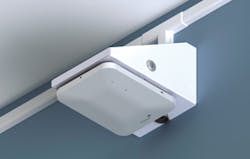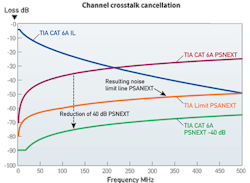From the October, 2013 Issue of Cabling Installation & Maintenance Magazine
802.11ac will take center stage, and 802.11ad will play a smaller role, in supporting mobile-data growth.
By Scott D. Thompson, Oberon Inc.
This is the second of a two-part article. Last month I presented a forecast for growth in mobile data based on the 2013 Cisco Visual Networking Index (VNI) report. This report forecasts that by 2016 wireless and mobile data traffic will exceed wired traffic, placing great burdens on wireless networks--both private WiFi network and public service-provider cellular networks. I presented some strategies for handling this rapid growth by building mission-critical WiFi networks and using mobile data handoff to WiFi networks. Another important part of satisfying the growing demand will be the use of emerging IEEE 802.11ac and 802.11ad amendments to the wireless standard to provide for gigabit mobile data. This involves engaging relatively unused spectrum in the 5- and 60-GHz bands.
Commercial WiFi networks, initially designed for casual Internet access, limited guess access and periodic conference room use, will be promoted to a mission-critical role, requiring improved throughput and connection reliability. Part of this improvement in performance will come from architecture and infrastructure improvements as described. However, there needs to be an increase in the data-handling capability of the wireless equipment, just as data cabling capabilities have advanced. Fortunately, the IEEE and industry participants have been working to create amendments to the 1997 IEEE 802.11 specifications for wireless networking. These new IEEE amendments, specifically IEEE 802.11ac and 802.11ad, are intended to support gigabit networking with an emphasis on video and multimedia content. IEEE 802.11 is the standard behind the WiFi Alliance's interoperability testing for WiFi certification, and the WiFi Alliance now has certification testing for the 802.11ac products, ensuring that certified client devices are interoperable with certified infrastructure access points.
About IEEE 802.11ac
The IEEE 802.11ac amendment is presently in a finalized state with working group approval anticipated later in 2013. The draft specification is far enough along that manufacturers have committed designs to silicon, and there are presently consumer- and commercial-grade 802.11ac products available. There are 802.11ac smart phones currently on the market, such as the Samsung S4 and HTC One. There are rumors that Apple and Intel will come out with 802.11ac-enabled laptops in 2013 also.
802.11ac exploits advanced modulation and coding, multiple spatial streams, beamforming, wider channel bandwidths, and the 5-GHz band only. Because of the ongoing improvements and capabilities of the chipsets, the WiFi Alliance has divided the certification of 802.11ac devices into two "waves." The first wave of silicon will support 80-MHz channels, and the second wave will support 160-MHz channels. (For comparison, 802.11n supports 40-MHz channels, and 802.11a/b/g supported only 20-MHz channels.)
In many enterprise installations 70 to 80 percent of the devices connect on the 2.4-GHz channel, and this band has become sorely congested. Many people consider the 2.4-GHz band a junk band due to its co-location with microwave ovens. 802.11ac completely abandons the 2.4-GHz portion of the spectrum for the 5-GHz band.
802.11ac is backward-compatible with 802.11n 5-GHz operation and, although 802.11ac itself does not support operation at 2.4 GHz, most 80.211ac-capable wireless access points will continue to support 802.11n, 2.4-GHz capability.
Of course, the big advantage with the 5-GHz band is that there is presently 440 MHz of bandwidth, permitting 22/10/5/1 discrete channels of 20/40/80/160 MHz respectively. With opening up of 5.35-5.47 GHz and 5.85-5.925 GHz bands (which may happen over the next year), the number of channels increases to 34/16/8/3 for each respective bandwidth, with a total of almost 700 MHz of bandwidth available.
80.211ac coverage at 5 GHz
One might be tempted to believe that because propagation at 5 GHz "is not as good as" the propagation at 2.4 GHZ, 802.11ac will not work as well as 2.4-GHz-based standards. The reality is that most networks now have a capacity issue, and not a coverage issue. So the somewhat smaller 5-GHz cells are an advantage when it comes to spectrum reuse and more-closely spaced access points needed to provide greater capacity. Wireless designers and equipment manufacturers are recommending higher wireless access point (WAP) density to handle the greater data capacity loads. The task group developing the ANSI/TIA-4966 Telecommunications Infrastructure for Educational Buildings and Spaces standard is considering recommending a WAP density of 1 WAP per 2,500 square feet in general spaces, and 1 WAP per 1,600 square feet in residence halls.
Many designers have used a rule of thumb that the 5-GHz WiFi cell is approximately half the area of a 2.4-GHz cell. There is variability in this rule, though, as in open areas the 5-GHz will propagate nearly as well as 2.4-GHz. However, through thick walls, 5-GHz will not propagate as well as 2.4-GHz. Early comparisons of 802.11ac products, compared to 5-GHz 802.11n products, indicate that coverage is roughly the same, as would be expected because they are both in the 5-GHz band. So networks designed around the 5-GHz cell can be upgraded to 802.11ac with WAPs in the same location. If the network is designed around the 2.4-GHz cell, then it is clearly time to update the wireless design to the 5-GHz cell, which will require higher WAP density. This, of course, is exactly what is needed to handle the higher capacity requirements.
If a new wireless 5-GHz design is planned, it is worth considering that the attenuation of the 5-GHz waveform through common construction materials is different from 2.4-GHz. The table shows the attenuation of the radio wave through various building materials at 900 MHz (representative of cellular networks), 2.4 GHz and 5 GHz. The table shows there may be a great deal of variation in the attenuation through a material. The low end of the scale is from ideal laboratory measurements of material when the radio wave strikes the material straight on at a low angle of incidence. The higher end of the range is from practical results, and where the radio wave may strike the material at a high angle of incidence. Note the high attenuation of the reinforced concrete (due to the embedded steel) and the "low e" glass (due to the metallic coating). This high attenuation is the reason cellular coverage is so poor inside some buildings.
Cabling for 802.11ac access point uplink
As 802.11n wireless networks were deployed, it was demonstrated that cabling capable of supporting Gigabit Ethernet was required, because MAC throughput could exceed 100 Mbits/sec. What will 802.11ac require? That may depend on what wave of technology is being deployed. As previously described, 802.11ac silicon will be rolled out in two waves, with the first wave delivering enterprise products in 2013 and the second wave in 2015. Because the second-wave silicon is able to process much wider bandwidth waveforms, it has a significant impact on data throughput. The table summarizes anticipated maximum data rates.
It can be seen that the first-wave products are adequately supported by the same Gigabit uplink infrastructure supporting 802.11n infrastructure. With the emergence of the second wave of silicon, however, the uplink may need to be enhanced, either by an upgrade to 10-Gigabit, or with two 1-Gigabit connections. (This assumes the WAP will provide you with two load-balancing 1-Gigabit jacks. A few years ago there were 802.11n wireless routers on the market with a single 10/100-Mbit/sec port!)
While planning WAP density and cabling type, it is more important now than ever to plan for the types of mobile devices and their density. For example, smart phones, the fastest-growing device segment, will probably use only one spatial stream, in order to conserve their limited battery capacity. (Spatial stream is a term for a technology used to improve data throughput. 802.11ac devices can use multiple spatial streams to improve throughput. Each spatial stream requires an additional radio transmitter and receiver, so the additional spatial streams have an impact on battery use.)
So if a second-wave access point is capable of 2,000 Mbits/sec MAC throughput with four spatial streams, then its throughput will only be one quarter of this, or 500 Mbits/sec, with one spatial stream. If the WAP is largely supporting a few smart phones with one spatial stream, and not four-spatial-stream laptops, then the 1-Gigabit Ethernet uplink is adequate, even for wave-two WAPs. On the other hand, wave-two WAPs will likely offer multi-user MIMO (MU-MIMO) capability. This will allow the WAP to simultaneously serve multiple clients at rated speed by essentially steering a beam to each device. So if four or more single-spatial-stream devices connect to the WAP at 300 Mbits/sec (MAC throughput) simultaneously, then the uplink will need to be greater than 1 Gigabit.
Look for high-performance WAPs to get bigger and more expensive as they incorporate more radios and more antennas for three to four spatial streams. 802.11ac access points may also need 802.3at or PoE Plus to be fully powered to use all available spatial streams.
Initial testing of 802.11ac products indicates that data throughput is approximately double that of the best 802.11n products. A lot of 802.11n users experience data throughputs of 100 Mbits/sec, and with 802.11ac will experience greater than 200 Mbits/sec throughput or more, especially as the technology matures. The WiFi Alliance says that the new technology delivers up to Gigabit performance, so the Gigabit uplink is adequate for the foreseeable future, but it may be worthwhile planning for multiple Category 6A cables to be pulled to individual access point locations, especially as wave-two products appear in 2015. The emerging TIA TSB-162-A Telecommunications Guidelines for Wireless Access Points will recommend use of Category 6A cabling, not only for data rate, but for remote powering of WAPs.
About 802.11ad, WiGig
The IEEE 802.11ad Very High Throughput at 60-GHz amendment is now a standard. Sometimes called WiGig, it can deliver up to 7-Gbits/sec of theoretical throughput (this probably will translate to a maximum MAC throughput of 4 Gbits/sec)—much more than even the wave-two 802.11ac WiFi network. However, propagation of the 60 GHz is much different from propagation at 5 GHz. This millimeter-wave wireless signal will not propagate through walls or around corners, so it is intended for use within a room. Vendors are aiming the system initially at device-to-device functions such as wireless docking, and in-room A/V networks for synchronization and linking to displays, such as projectors. Since this technology is constrained to in-room use, the impact on the cabled network is reduced.
Using the capabilities of 802.11ad, think of how classrooms and workspaces will be designed in the future. Students and workers will be using BYOD laptops, tablets and smart phones. The fixed workstations will go away. There will be fewer fixed outlets and data drop poles, and there will be a higher density of WAPs architecturally blended into the ceiling or wall, operating in different bands and servicing different wireless subnets. There may be an independent wireless data and A/V network in the room. The wireless networks will comprise premises WLAN, A/V support equipment, and local device-to-device communications.
Optical wireless
We have been using optical wireless communications for a long time--longer than other parts of the electromagnetic spectrum (think of lighthouses, signal flags, smoke signals, etc.). Now, with light-emitting diodes (LEDS) and lasers, opportunities for enormous bandwidths are available. There is no licensing in optical wavelengths, so the entire optical spectrum (consisting of terahertz of bandwidth) is available for communications by anyone. Light waves are secure--they do not pass through walls--and they are free from electromagnetic interference.
Like the wireless communications at 60 GHz, optical wireless will be restricted to in-room applications, and because light does not pass through or around bodies, it will be "line-of-sight." Think of how you point and click your TV remote control. Researchers are working on ways to sustain high data rates with scattered and reflected light waves, though. The Infrared Data Association is working on new standards for multi-gigabit capabilities up to 3 meters, with a broader angle of coverage for device-to-device communications. The IEEE 802.15.7 task group is working on a subset of optical communications called Visible Light Communications (VLC). This is using visible-light LEDs to not only light a room, but provide data communications. No more searching for a wireless signal; you could actually see where you can pick up a signal.
The capability of wireless networks is improving, but always provides perhaps one-half to one-tenth the data throughput capability of the prevailing cable technology. This is likely to remain true as the wireless propagation environment is very challenging. Wireless is more about mobility than eliminating wires, but just as people have abandoned their wireline phone for their mobile phone, they will abandon their fixed data connection for their mobile data connection, now more than ever. To support this growing mobile data demand the density of access points in the wireless LAN will continue to increase, requiring serious consideration of how the cabled network will support more access points requiring higher-speed uplinks. As the saying goes, "Wireless isn't." ::
Scott D. Thompson is president of Oberon Inc. (www.oberonwireless.com) and a senior member of the IEEE.
Archived CIM Issues



